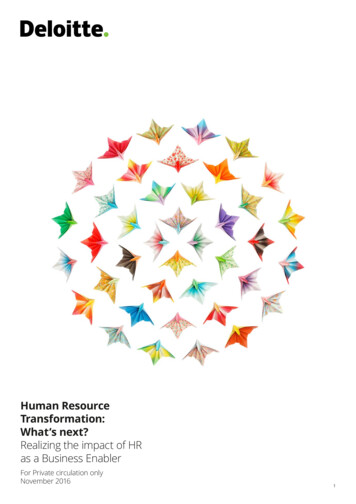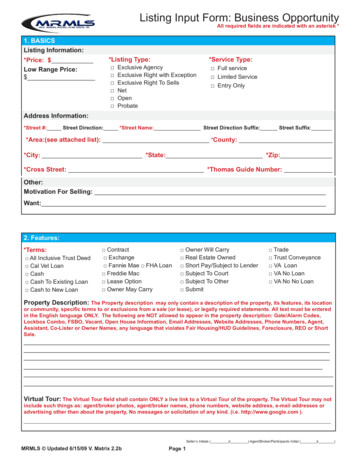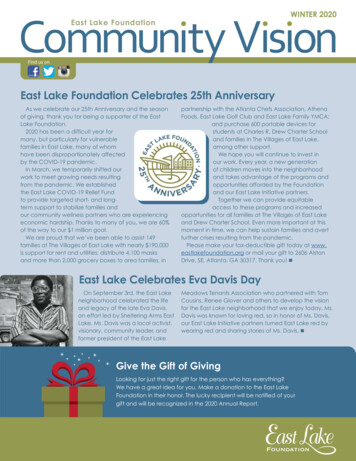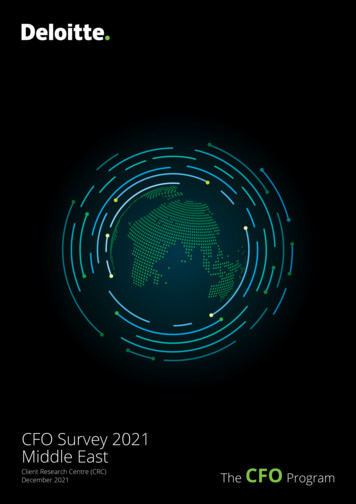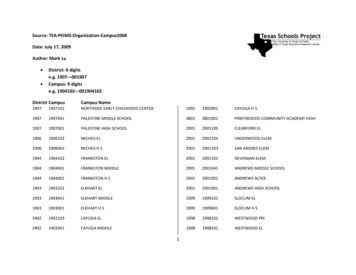
Transcription
Middle EastPoint of ViewPublished by Deloitte & Touche (M.E.) and distributed to thought leaders across the region Summer 2017Security, sustainability,stabilityThe 3S family plan5G MobileNetwork like never beforePaid tax, will travelThe changing landscapeof business travelThe only certainty is.Build it and run?The case for constructionrisk management
Deloitte A Middle East Point of View - Summer 2017 Summer 2017Middle East Point of ViewPublished by Deloitte & Touche (M.E.)Read ME PoV on your iPad.Download ME PoV app.www.deloitte.com/middleeast2
Deloitte A Middle East Point of View - Summer 2017 EditorialA word from theeditorial teamNothing is certain except death andtaxes. So said Benjamin Franklin in 1789.Since then, there is much that hasbecome certain, such as uncertainty,wars, tax evasion, money laundering andbusiness travel to name but a few. Oh,and mobile telephony. Future historianswill eventually make sense of ouruncertain and unpredictable times. Fornow, we will just have to go with the flow.It does help, however, to try and makesense of the world around us and this isprecisely what our contributors do in thisissue of Middle East Point of View. It isindeed a careful world we live in andmuch has become about assessing riskand mitigating it.But there is still much room forexcitement, especially as regards theadvancement of technology. Enter 5G,the fittest and fastest mobile network sofar. Emmanuel Durou, Pedro Tavares,Guilherme Oliveira, Hugo Pinto, PedroVenâncio, and Gonçalo Horta review thenew network and the challenges faced bymobile operators. Despite the need formonetization, the authors say: “Morethan ever, Telcos cannot afford to missthe proverbial 5G boat—it is not aboutdifferentiation anymore, it is aboutsurvival of the fastest in every sense ofthe word.”Mitigating risk is of increasing importancefor both banks and the constructionindustry. Reduced liquidity due tochanging market dynamics, namely areduction in oil prices, is forcing banks inthe GCC region to rethink their lendingpolicy due to a rise in Non-PerformingLoans. David Stark and Karim Labbanadvise in their article NPLs on the rise thatcorporates “should seek creativefinancing and restructuring solutionsto mitigate default risk and engage intransformation initiatives to adapt tothe changing dynamics of the market.”The effects of tighter financial policiesin the Middle East, according to MattHanson, can certainly be felt in theconstruction industry and are leading toslightly more careless contracts. This iswrong, he says in his article The case forrisk management in the Middle Eastconstruction market, as “tightmanagement of project costs and clearvisibility of project risks will becomecritical in ensuring overruns are avoidedand stakeholders retain confidence in anorganization’s ability to deliver projectssuccessfully.”Even business travel is no longer immuneto taxes and risk. As organizationsbecome more global, says Jayne Stokesin her article Business Travel, managingrisk in an evolving landscape, “employeesare increasingly expected to take onglobal or regional roles [giving rise] to acomplex array of tax, immigration andpayroll risks for both the organizationand the employee.”And what better for mitigating risk thanan insurance policy? That is preciselywhat Walid Chiniara and Yasmine Omaripropose in their article The “Triple S”family business insurance policy. Although“there is no standard “Family business”insurance policy,” per se, “it is possible toput in place a governance structure, akinto an insurance policy, to safeguard thecapital of a family in all its forms: financial,human, social and intellectual.”No issue of our magazine would becomplete without a commentary onreporting and anti-money launderingstandards. Angelito Catacutan reviewsthe “Big Change” in IFRS 15, that affectsthe recognition criteria of revenue andwill surely affect many industriesespecially some of the big real estateplayers and key telecommunicationscompanies, who have chosen an earlyadoption of the standard.Roy Gillespie, in his article ISO 37001anti-bribery management system: time forimplementation outlines the requiredmeasures and fundamental elements toensure a successful implementation ofthe system, including top-levelcommitment, communication andadequate resources and budget.Finally, Andrea Derler, Anthony Abbatiello,and Stacia Garr discuss the five ways tonurture developing leaders in their articlereprinted from the Deloitte Review, Betterpond, bigger fish. “Developing futureleaders isn’t just about putting themthrough programs,” they say, “newresearch points to the critical importanceof supporting them with the rightorganizational context—a workplaceenvironment that encourages knowledgesharing, risk-taking, and growth.”We are fairly certain that you will find thisissue of the Middle East Point of View asinformative and pertinent as ever, ascertain as we are of paying our taxes.ME PoV editorial team03
Deloitte A Middle East Point of View - Summer 2017 ContentsContents06The “Triple S” familybusiness insurance policyWalid Chiniara and YasmineOmari30Better pond, bigger fishFive ways to nurturedeveloping leaders inan ecosystem for growthAndrea Derler, AnthonyAbbatiello and Stacia Garr04
Deloitte A Middle East Point of View - Summer 2017 Contents10182226Survival of the fastest5G – A glimpse into theexpectations and challengesof next generation mobilenetworksEmmanuel Durou, PedroTavares, Guilherme Oliveira,Hugo Pinto, Pedro Venâncioand Gonçalo HortaBusiness travelManaging risk in an evolvinglandscapeJayne StokesThe case for riskmanagement in theMiddle East constructionmarketMatt HansonNPLs on the riseDrivers and mitigatingmeasuresDavid Stark and KarimLabban4044IFRS 15 Revenue fromcontracts with customers:Are you ready for the“Big Change?”Angelito CatacutanISO37001 anti-briberymanagement systemTime for implementationRoy Gillespie05
Deloitte A Middle East Point of View - Summer 2017 Family business06
Deloitte A Middle East Point of View - Summer 2017 Family businessThe “Triple S”family businessinsurance policy07
Deloitte A Middle East Point of View - Summer 2017 Family businessThere is no standard“Family business”insurance policy that cantruly mitigate and coverall the risks associatedwith a family-ownedbusiness.There are various underlyingprinciples that propel individualsto purchase insurance policiesdepending on their needs, be it tosafeguard and protect their business,their assets, their family or theiremployees. These principles can also beapplied within a family business context.While key policies may protect thebusiness to a certain extent, andlife/health insurance policies will protectthe family and employees to a certainextent, the coverage is understandablylimited when considering the biggerpicture: that of a family business.There is no standard “Family business”insurance policy that can truly mitigateand cover all the risks associated with afamily-owned business. However, it ispossible to put in place a governancestructure, akin to an insurance policy, tosafeguard the capital of a family in all itsforms: financial, human, social andintellectual.- What if I break my leg on a skiingholiday?- What if my bag is stolen?- What if my house catches fire?But there are also many “what ifs” thatcan affect a family business, such as:- What if one of the family shareholderswishes to exit?- What if the key family executive(s)passes away or wishes to leave thecompany?- What if family members have differentideas about the commercial direction ofthe company?- What if my children want to set up abusiness in competition with the familybusiness?- What if I work harder than my sibling(s)but they receive the same salary as me?- What if a family member wants to jointhe firm, but does not have the rightskills or attitude?Insurance policies are also used toprovide financial security in the case ofunfortunate and unforeseen events,ranging from the merely inconvenientto the truly life-changing.What if?While in some instances it is a legalrequirement to have insurance policies inplace (such as medical insurance for UAEemployees), insurance policies are alsoused to provide financial security in thecase of unfortunate and unforeseenevents, ranging from the merelyinconvenient to the truly life-changing:- What if I crash my car?08Any one of these scenarios can upset thedelicate balance within a family, which inturn can generate financial, commercialand moral repercussions for the family,the business and its employees. So whynot put in place a plan to secure thefinancial and commercial viability in theface of potential shocks that may affectthe business?
Deloitte A Middle East Point of View - Summer 2017 Family businessThe Triple S family business insurancepolicyThe first step to mitigate against thesescenarios is to recognize that runninga business and being a family are twoseparate matters. When the two becomeintertwined there is a need to createboundaries and rules. Family governanceis the Triple S (3S) insurance policy thatensures the long-term security,sustainability and stability of the familybusiness.A Summary of the 3S insurancecoverageThe coverage required will differ fromfamily to family, but typical clausesshould: Set out core values to which allmembers of the family should adhereto, so as to ensure that the familyidentity and cultural capital is upheld; Set out a family investment policy i.e.strategy of operating businesses,investments and family office; Define a succession plan to secure asmooth transition from one generationto the next; Provide a mechanism for decisionmaking among the family; Define a dividend policy that meets theneeds of both, the family and thebusiness and to ensure that familymembers’ expectations are managed; Provide a way for next generation familymembers to be given responsibility formatters within the governanceframework, provide mechanisms fortheir employment and integration intocompany operations; Provide agreed-to mechanisms forconflict management between familymembers; and, Provide a means for articulating thefamily's philanthropic vision and puttingit into effect.In essence, the family governanceframework addresses all the potential“what-ifs” associated with a familybusiness. It addresses the concerns ofthe different stakeholders within thefamily structure and it defines the rolesand guidelines under which they shouldoperate.Agreeing on such a framework in advanceallows the family to decide how to resolveproblems and conflicts before they arise.Without a prepared response strategy,dealing with an unexpected problem atthe same time as finding the rightsolution is not always immediatelypossible; any delay can cause a relativelyminor issue to snowball into a muchmore problematic matter.Governance is more than a hypotheticalideal or a physical or legal structure putin place to safeguard a family's wealth. Itis the rules of operation for a given family,a set of systems and policies by which afamily and all of its members can interactand work together to promote thefamily’s vision and philosophy whilemaximizing returns and preserving thefamily's asset base.It is important to realize that a familygovernance framework cannot beimposed on a family, rather, it must bedeveloped by the members themselves.In the same way that insurancepremiums are based on an actuarialassessment of the risk of the insuredindividual/item, there are many factorswithin each family business that will affectthe design and coverage of the Triple Sinsurance policy.While there is a financial investmentassociated with implementing agovernance policy, this can be far lessthan the long-term risks (and consequentcosts) of inaction such as a forceddisunion of a company, a stifled orineffectual board, loss of commercialopportunities, irreparable damage tofamily relationships or costly litigationand other legal bills.Family governance is theTriple S (3S) insurancepolicy that ensures thelong-term security,sustainability andstability of the familybusiness.Governance or succession planning isnot a mandatory legal requirement but maybe it should be?The economic and social fallout of thefailure of a large family business shouldnot be underestimated, nor should theimpact of the damage caused torelationships within the family.As with all insurance policies, it isimportant to shop carefully and becertain of the extent of the coverageprovided. Make sure the 3S policypurchase is adequate for the needs ofthe family and business. Just as businessinsurance policies can be changed andcustomized to suit the needs of thebusiness and family, so can any givengovernance policy.After all, entrepreneurs work so hardbuilding their business, serving thecommunity and creating employment,they owe it to themselves to ensure thattheir hard work has not been in vain, andthat the family business is adequatelyprotected. To quote Henry DavidThoreau, “if you have built castles in theair, your work need not be lost; that iswhere they should be. Now put thefoundations under them1.”by Walid Chiniara, Partner and Head ofFamily Enterprise Consulting, Deloitte,Middle East and Yasmine Omari,Manager, Family Enterprise Consulting,Deloitte, Middle EastEndnotes1. Henry David Thoreau, Walden,185409
Deloitte A Middle East Point of View - Summer 2017 5GSurvival ofthe fastest5G – A glimpse into theexpectations and challengesof next generation mobilenetworks5G is seen by the telecoms industry as the key buildingblock of our future mobile digital world and ournetworked society. Can the technology live up to itsexpectations?10
Deloitte A Middle East Point of View - Summer 2017 5G11
Deloitte A Middle East Point of View - Summer 2017 5GWay beyond just speedimprovements, 5G isexpected to enablecontinually connectedservices with much lowerlatency than what iscurrently experiencedtoday in mobile networks.5th Generation Mobile Network, or 5G, isthe new generation of mobile networksthat will enable a range of newapplications from Internet of Things (IoT)to self-driving cars, through higherspeeds and lower latencies. Thedeployment of 5G networks is slated tobegin in 2020 and there are significantefforts underway by Telcos to developthe business cases for 5G. This articleexamines the enabling aspects to making5G a reality, as well as the challengesand concerns ahead that need to beaddressed during the 5G standardizationand implementation journey.The new Telco Graal5G is expected by many to be theforthcoming revolution in mobiletechnology. Way beyond just speedimprovements, 5G is expected to enablecontinually connected services with muchlower latency than what is currentlyexperienced today in mobile networks.5G will also enable the massive roll-out ofconnected sensors and bring aboutmass-market IoT—think trillions ofconnected devices. Thanks to higherreliability, flexibility and with a variety oftrade-offs between speed, latency andcosts, 5G promises to bring to marketa range of new services and serviceimprovements as presented in thegraphic below.However, a number of new and existingconditions need to be in place to reapthe full benefits of 5G. Thesetechnologies, which go from radio tocore, are yet to be developed and/orimplemented. Among these, availabilityof the right spectrum bands for 5Gdeployment will be key. 5G will also besupported by the new generation ofradio technologies (e.g. cognitive radio)coupled with new equipment andtechnologies (e.g. Software DefinedNetworks) in the Access and Corenetworks.5G possibilities and opportunities for several industriesALWAYS BEST CONNECTEDCombination of 4G and new radioaccess technologies to provide afully covered mobile experienceNO PERCEIVED DELAY5G will provide 5x-10x lowerlatencies compared to previousmobile generation technologiesENERGY EFFICIENCY5G will enable resource savingthrough virtualization, and anas needed type of usageFLEXIBLE NETWORKSBased on virtual systems, 5Gwill be flexible so operatorscan support their new demandsSource: European Commission12AMAZING DATA VOLUME5G will be capable to supply10x-100x higher data rates thanLTE technologies5GThe critical buildingblock of our digital societyIOT & LOW BITRATES5G will support the massificationof low data volume links betweenthings, individuals, and bothCRITICAL SERVICES5G high reliability and 99.999%availability will manage missioncritical type of servicesSECURE NETWORKSTo cope with a software basednetwork, 5G security willprovide a qualitative leap forward
Deloitte A Middle East Point of View - Summer 2017 5GOnce these are in place, the three mainapplications of 5G that will most affectour everyday lives are:1. Enhanced mobile broadband—allowing seamless customerexperience from a broadband speedpoint of view and the rise of newapplications on-the-go such as UHDAugmented Reality;2. Massive Internet of Things—essentiallyenabling the smart cities of the future;3. Mission Critical Control—a must in thedemocratization of applications suchas self-driving cars.Telcos need to gain a clear picture onthe monetization potential and returnon investment for 5G. Beyond strategy,there are clear operational challengesahead for the 2020 planned 5Gdeployment.5G main use cases5G ENABLING ASPECTSExtreme DATA RATES: Multi-gigabits persecond, for, e.g. UHD virtual reality- Non exhaustive -Uniform USER EXPERIENCE: At least100 Mbps everywhere, not impacting ed spectr.5G New RadioRADIOMECC-RANUltra- LOW ENERGY: 10 yearsof battery lifeMassiveInternet ofThingsMassive MIMOOptimized OFDMACCESSUltra- HIGH DENSITY: 1M devices/Km2,for the hyper connected NW visionSub 6GHz bandswill allow Deep COVERAGE: To reachchallenging locationsMission CriticalControlStrong SECURITY: Critical communications,e.g. government/financial trustedMulti-RATCORENFV/SDN & MANONew architectureWith great expectations come greatchallengesWith new applications will come newbusiness models for Telcos. However,Telcos need to gain a clear picture on themonetization potential and return oninvestment for 5G. Beyond strategy, thereare clear operational challenges aheadfor the 2020 planned 5G deployment.Ultra- LOW BIT RATES: 10’ ofbits per sec., for monitoring NWUltra-high RELIABILITY: 1 out of 100Mpackets lost, needed for critical applicationsUltra-low LATENCY: Low as 1 ms, for, e.g.autonomous driving and virtual realityOver the next few years, mobileoperators will continue to face increasingmargin pressure as data traffic continuesits exponential growth, while operators’revenues grow at single digit pace, if any.As traffic keeps growing, operators mustreduce cost-per-bit, as revenues will keepon decoupling from traffic growth. Thus,it is vital for the mobile operators to13
Deloitte A Middle East Point of View - Summer 2017 5GFrom the perspective ofnetwork operators, newbusiness models willemerge with 5G leadingto new ways ofmonetizing thenetwork—buildingecosystems for smartcities and IoT being twoof the many examplesof new models enabledby 5G.reinvent their business models toaddress this challenge and exploitservice differentiation in order to protectmargins. From the perspective of networkoperators, new business models willemerge with 5G leading to new ways ofmonetizing the network—buildingecosystems for smart cities and IoT beingtwo of the many examples of new modelsenabled by 5G.Overall we believe that three types ofnew business models will be supportedby 5G deployment:- On the consumer side, userdifferentiation that includes superfastbroadband, ultra-high definition videoto mobile devices and virtual reality;- On the corporate side, Network as aService (Naas) and informationbrokering, a byproduct of IoT andanalytics.5G business models for operatorsOPERATORSBUSINESS MODELSUSER DIFFERENTIATION for consumerNETWORKPERFORMANCEConnected Real timehomework in cloudPOWERED BY:XXL BroadbandNETWORKSLICINGDATA8K video 4Kbeamer videoUHD VideoVirtual Augmentedpresence realityVirtual RealityNETWORK AS A SERVICE for corporateSafety &securityAuto.Trafficmgmt.HealthUtility &energyComs.LogisticsTailored vertical NaaS XaaS solutionsINFORMATION BROKERING for corporateSelfdrivingTrafficmgmt.Traffic systems14LogisticsFactoryIndustrial Smartautomation applications gridsAdvancedlogistics & productionMassive meteringThe first business model, aimed at theconsumer, allows operators to takeadvantage of increased networkperformance to provide newdifferentiated services for end users(such as augmented reality.) In the caseof NaaS, enabled over networkvirtualization, the focus is on corporatecustomers’ needs. Operators can exposetheir Operations Support Systems (OSS)and allow corporate customers toconfigure their networks (network slices)in the way that best suits their needsdepending on their industry verticals.Information brokering, also aimed atthe corporate segment, intends to usethe transactional and control dataproduced by 5G networks to empowernew services that benefit from contextualreal-time and non-real-time data.Operators can broker critical servicesinformation to industry, where eventsneed to be addressed in real time: forinstance in the assembly lines ofautomated factories.However, many strategic and operationalchallenges lay ahead that need to beovercome on the road to a full andoptimal 5G deployment. In many ways,5G is posing transformational questionsto Telcos on the rise of new businessmodels, the need to operate in a moreefficient and mission critical way and, ofcourse, the adaptability of the operatorsto new technological challenges. Inaddition, to start the journey, the currentlack of 5G standardization creates a riskfor Telcos in divergent technologydeployment that will in turn lead tohigher costs and compatibility concerns.
Deloitte A Middle East Point of View - Summer 2017 5GChallenges that need to be addressed for 5G deploymentTransformationStandardsAs operators begin 5G activitiesahead of standardization,identifying use cases andmoving faster than standardswork, there is an increasing riskof divergence in 5Gdeployments.From an operator point ofview, transform its currentOSS and BSS platforms intoa convergent MANO solutionacross its overall networkoperations will be a majorchallenge to be solved priorto full 5G adoption.“Killer use cases”There is a need to definitelyanswer to the question of whereis the intersection betweeneconomics and long-terminfrastructure for the 5G 2020deployment.road toCHALLENGESSTILL AHEAD5G2020SpectrumIPv6 & Massive IoTDecisions are yet to be made onspectrum availability for 5G.New bands below 6GHz andabove 24GHz are still yet to bedefined, and judgments onspectrum refarming are yet tobe made.Thus, to prepare for 5G, mobile operatorsneed to make objective decisions onwhen and how to make the requirednetwork investments, and need to takeinto consideration the operationalchanges that are required to evolve to a5G environment. The key steps of thisevolution are shown in the graph below.The needed IPv6 adoption tosupport the massive IoT willhave to be guaranteed byoperators in their networks, ifone wants to take advantage ofthe full spectrum of 5Gpossibilities.SecurityWith the IT-driven 5Garchitecture, and its nontelco protocols moresusceptible to hack, thecritical services on top of thenetwork will demand extraattention to security.To prepare for 5G, mobile operatorsneed to make objective decisions onwhen and how to make the requirednetwork investments.Overall business transformation processPhase 3 & 2 in parallel12Prepare for 5GPLANBUILD SOLIDBUSINESS CASE(s)In-depth view of techchoices and impactsTechno-economic modelsto validate business casesOptimal radio evolutionfor selected journey5G spectrum assessmentfor optimal useNew processes and newtoolsSelect the right strategy/journey path to 5GOperationalize 5GVIRTUALIZE &ORCHESTRATE WITHNFV/SDNPLAN 5G NETWORKAND OPERATIONDefine 5G strategy andenvisioned use cases3 RUNDeploy 5GDESIGN & BUILDBUSINESS TRANSFORMATIONPROCESSMIGRATE CORETO A FULL-SCALECLOUDDEPLOY ANIOT OFFERIMPLEMENT 5G NEWRADIOAdopt the right technology and developthe right skills, tools, and processesDue to 5G“softwarization” oftelco network (e.g. NFV,SDN, slicing, etc.)common organizationalareas will need betterinteraction with eachother to solve day-to-dayproblems, such as IT andEngineering, thus theneed for a structuralredesign15
Deloitte A Middle East Point of View - Summer 2017 5GSmoothing the transition from4G to 5GTransition technologies such as LTE Advance Pro (4.5G) will bridge thetransition from 4G to 5G networks,allowing operators to maximize thevalue of their current networks.Mobile Telcos continue to build out theirLTE networks with a push to upgrade toLTE-A and are also looking to advance to5G. However, prior to the 5G rollout amid-step will take place, more specificallyLTE-Advance Pro or 4.5G. 4.5G will bebackward compatible with prior LTEreleases, increasing 4G capabilities withmulti-gigabit per second bitrates andeven lower latencies.4.5G will begin providing the capabilitiesto support new 5G use cases, allowing toadjust network architectures ahead oftime for 5G deployment. In addition, 5Gnetworks will need a networkarchitecture that meets certainrequirements, such as adaptation todifferent service types, network slicingand backhaul requirements for lowerend-to-end latency and ultra-highbandwidth. This will be enabled byparallel developments on NetworkFunction Virtualization (NFV) andSoftware-Defined Networking (SDN).As of today, 5G is still in its technicalrequirements definition, with inputsprovided from different standardizationorganizations, prior to its expectedrelease in 2020. The following diagramshows the predicted roadmap for 5G.Advance Pro (4.5G) willbridge the transitionfrom 4G to 5G networks,allowing operators tomaximize thevalue of their currentnetworks.Roadmap for 5G deployment20142015Release 1320162017Release 142018Release 15e-MTCLatencyNB-IoTChannelmodelEnhanced mobilebroadbandEPCenhancementsSecurity in5GMassiveMTCMissioncriticalEnhanced mobile broadbandabove 6GHz162019Release 16
Deloitte A Middle East Point of View - Summer 2017 5GConclusionTelcos will continue to experience doubledigit growth—estimated at a 23 percentcompound annual growth rate (CAGR)up to 2020—in data traffic, meaning thatthey need to keeping investing in newinfrastructure and expansion to attendthe market demand. Additionally,competition from OTTs are erodingrevenues that are not growing at thesame pace as their capital expenditure(CAPEX.) Thus, it has become a survivalimperative for operators to rethink theirbusiness and operating models. Serviceproviders are aiming to reinventthemselves into agile digital playerslooking for new sources of revenues,developing innovative value addedservices, reducing time to market andcutting their cost to serve. A successfultransition to 5G becomes therefore oneof the cornerstones of thistransformation.Until 2020 there will be multiplechallenges related to a successful 5Gimplementation. The telecommunicationsindustry is going through a period ofprofound mutation and 5G will play acrucial role in the operators’transformation agendas. More thanever, Telcos cannot afford to miss theproverbial 5G boat—it is not aboutdifferentiation anymore, it is aboutsurvival of the fastest in every senseof the word.Service providers are aiming toreinvent themselves into agile digitalplayers looking for new sources ofrevenues, developing innovative valueadded services, reducing time tomarket and cutting their cost to serve.A successful transition to 5G becomestherefore one of the cornerstones ofthis transformation.by Emmanuel Durou, Partnerand Technology, Media andTelecommunications Leader, Deloitte,Middle East, Pedro Tavares, HeadPartner of Deloitte ́s Telecom EngineeringExcellence (TEE), Deloitte, Portugal,Guilherme Oliveira, TEE Manager,Deloitte, Middle East, Hugo Pinto, TEESenior Manager, Deloitte, Portugal,Pedro Venâncio, TEE Senior Consultant,Deloitte, Portugal and Gonçalo Horta,TEE Consultant, Deloitte, Portugal17
Deloitte A Middle East Point of View - Summer 2017 Business travelBusiness travelManaging risk in an evolvinglandscape18
Deloitte A Middle East Point of View - Summer 2017 Business travelAs organizations become more global, traditionalmobility types are becoming rarer—employees areincreasingly expected to take on global or regionalroles, travelling to emerging markets and beingrequired to fulfill short-term project needs. Thisexpanded global footprint, together with an everincreasing interdependence between tax andimmigration, gives rise to a complex array of tax,immigration and payroll risks for both theorganization and the employee.19
Deloitte A Middle East Point of View - Summer 2017 Business travelIndividuals are frequentlyexpected to take onregional or global roles,with oversight not only ofthe teams or markets inwhich they are based, butalso within otherjurisdictions in theirregion and beyond.20The global nature of workThe way in which businesses operatetoday has evolved significantly from howthey operated ten years ago.Organizations increasingly need to bedigitally agile—businesses can no longercontinue to operate in rigid hierarchicalstructures, but need to work in networksof teams that cross functions, servicelines and, in many cases, jurisdictions.Within this context, individuals arefrequently expected to take on regionalor global roles, with oversight not only ofthe teams or markets in which they arebased, but also within other jurisdictionsin their region and beyond. This isparticularly relevant within the MiddleEast given the relative size of the regionand the number of countries itencompasses. It is feasible that anindividual based in the United ArabEmirates (UAE) will have a remit over thewider Gulf Cooperation Council (GCC)region, if not further afield intojurisdictions as diverse as Iraq, Iran o
the "Big Change" in IFRS 15, that affects the recognition criteria of revenue and will surely affect many industries especially some of the big real estate players and key telecommunications companies, who have chosen an early adoption of the standard. Roy Gillespie, in his article 37001 - : &*-)"*" 1 1&, outlines the required

